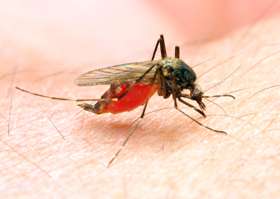Your basket is currently empty!
Designing-a-Malaria-Vaccine
Designing a Malaria Vaccine
Medical Research Council study characterizes immune responses in malaria-exposed individuals to find an immunodominant epitope.
Bisseye, C. et al. (2011). An engineered Plasmodium falciparum C-terminal 19-kilodalton merozoite surface protein 1 vaccine candidate induces high levels of interferon-gamma production associated with cellular immune responses to specific peptide sequences in Gambian adults naturally exposed to malaria.
Clinical & Experimental Immunology. 166(3):366-73. [PubMedID:22059995]
In 2010 there were 216 million cases of malaria and an estimated 655 000 deaths. In Africa, where the malaria-causing parasite Plasmodium falciparum is most prevalent, malaria accounts for more than 20% of all childhood deaths.
Researchers at the Medical Research Council (MRC) in the UK and in the Gambia are working to understand the immune response to Plasmodium, and hope to use this insight to design a vaccine to boost immunity and so reduce the number of deaths from malaria infection.
| An immune response to a Plasmodiumprotein called MSP1 (merozoite surface protein 1) is known to be protective against malaria. The response against MSP1 prevents parasites moving from the bloodstream into erythrocytes, and also impairs parasite development with erythrocytes, so parasite load is diminished and patient survival becomes more likely. Building on this natural protection to design a more immunogenic version of MSP1 is one strategy being explored for malaria vaccine development. Wild-type MSP1 is known to contain CD4+ T cell epitopes essential for generating an immune response, but modified MSP1 has yet to be fully characterized. Cyrille Bisseye and colleagues at the MRC used peptide libraries designed by ProImmune in their experiments to characterize the immune response elicited by modified MSP1. | 
Mosquitoes carry the parasite Plasmodium falciparum, which causes malaria |
The team recruited 43 volunteers from a village in The Gambia; all of the volunteers had previously been exposed to malaria but none had any symptoms, so could be classed as ‘semi-immune’. Blood samples from the volunteers were used in a series of immune assays to look at the response to wild-type and modified MSP1. ProImmune designed and manufactured custom peptide libraries spanning the sequences of wild-type and modified MSP1, using a library design of 20-mer peptides overlapping by 10 amino acid residues. Bisseye et al then used these peptides as antigens in an ELISpot experiment and measured the number of IFNɣ-secreting cells present in their donor samples. They found that one particular peptide (P16), both in a wild-type and mutant form, elicited a response in 63% of the donors, and also stimulated large numbers of cells to produce IFNɣ, as measured by ELISpot. The responding donors had a variety of HLA types, so the P16 peptide would be a useful vaccine candidate.
The level of different cytokines (IL-13, sCD30 and IFNɣ) secreted was measured for each peptide using the culture supernatants from the ELISpot assay. Interestingly, the peptides derived from modified MSP1 elicited higher levels of IL-13 than their wild-type counterparts, which may be useful in efficient activation of antibody responses.
This study has provided useful information which will contribute to the design of future vaccines to combat malaria, and shows how well-designed peptides can be used to dissect the immune response to a whole protein.
